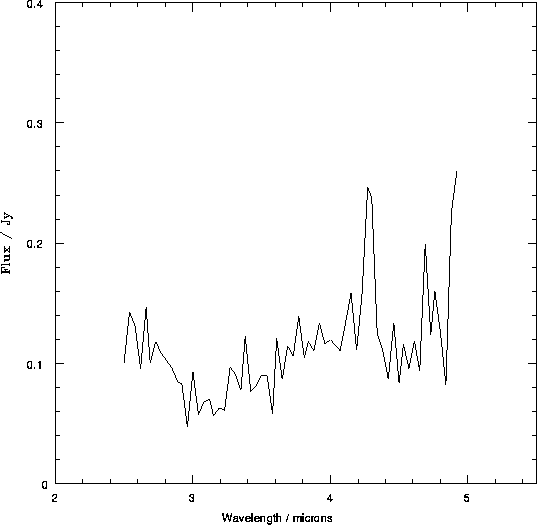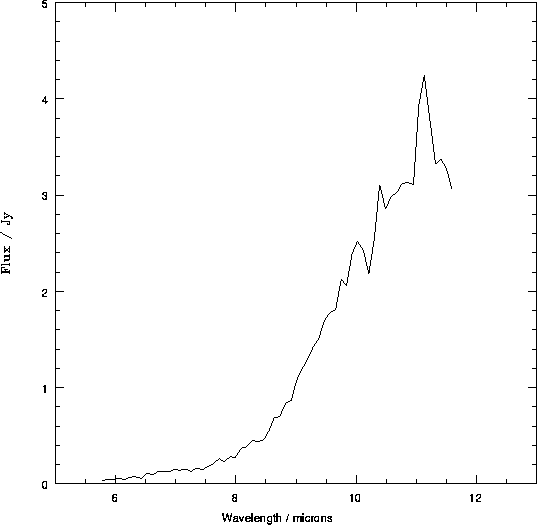Next: The re-opening of PDEC Up: ISO Info no. 10 Previous: SWS probes the power
The IR spectrum of Hale-Bopp
Comet C/1995 O1 (Hale-Bopp) is a long period comet discovered in mid-1995
when it was 7 AU from the Sun. At that time it was already very active and
200 times brighter than comet Halley at the same distance, making it an
exceptional comet. It was therefore selected as an ISO Target-of-Opportunity.
It was first observed on 27 April 1996 with the PHOT-S spectrometer of ISOPHOT
when it was at 4.6 AU from the Sun. The resolution in the 2.5-12 ![]() m
region was about 85, that in the 6-12
m
region was about 85, that in the 6-12 ![]() m range was about 95.
Integration time was of 4096 seconds, and a sky background observation was made
at the same sky position some days later.
m range was about 95.
Integration time was of 4096 seconds, and a sky background observation was made
at the same sky position some days later.
The data shows that the continuum in the 2.5-5 ![]() m region (see figure 1)
is too low to be detected. An obvious feature in this spectrum is the CO2 v3 band. The observed intensity corresponds to a CO
m region (see figure 1)
is too low to be detected. An obvious feature in this spectrum is the CO2 v3 band. The observed intensity corresponds to a CO ![]() production rate
of about 1.3 1028 molecules s -1. Various other emission bands
are expected in this 2.5-5
production rate
of about 1.3 1028 molecules s -1. Various other emission bands
are expected in this 2.5-5 ![]() m region, such as the CO 4.67
m region, such as the CO 4.67 ![]() m
line, the v3 (2.66
m
line, the v3 (2.66 ![]() m) and v2 (6.27
m) and v2 (6.27 ![]() m) bands of
water, the 3.2-3.6
m) bands of
water, the 3.2-3.6 ![]() m emission band from methanol and other
unidentified species. These are not detected, but their upper limits agree with
what is expected from this comet at such a distance from the sun. The ISO
observations show that CO
m emission band from methanol and other
unidentified species. These are not detected, but their upper limits agree with
what is expected from this comet at such a distance from the sun. The ISO
observations show that CO ![]() , CO and water are major volatiles that drive
cometary activity at large heliocentric distances. This contrasts with the
activity at small heliocentric distances, driven by water with much less
CO
, CO and water are major volatiles that drive
cometary activity at large heliocentric distances. This contrasts with the
activity at small heliocentric distances, driven by water with much less
CO ![]() and CO.
and CO.
The 6-12 ![]() m spectrum (figure 2) shows thermal emission at a colour
temperature of 162 K (6-8
m spectrum (figure 2) shows thermal emission at a colour
temperature of 162 K (6-8 ![]() m range) and a strong silicate band around
10
m range) and a strong silicate band around
10 ![]() m, with a narrow feature at 11.2
m, with a narrow feature at 11.2 ![]() m indicative of
crystalline silicates. This feature has traditionally been interpreted as due
to the presence of crystalline olivine grains. The absence of emission at 6.2,
7.7 and 8.6
m indicative of
crystalline silicates. This feature has traditionally been interpreted as due
to the presence of crystalline olivine grains. The absence of emission at 6.2,
7.7 and 8.6 ![]() m rules out PAHs as candidates for the 11.2
m rules out PAHs as candidates for the 11.2 ![]() m
emission. Olivine bearing submicrometric grains exhibit their main IR bands
between 11.2 and 11.3
m
emission. Olivine bearing submicrometric grains exhibit their main IR bands
between 11.2 and 11.3 ![]() m , the exact location depending on composition,
and Olivine also shows structure near 10.5
m , the exact location depending on composition,
and Olivine also shows structure near 10.5 ![]() m similar to the comet
spectrum. It is the leading candidate for these features.
m similar to the comet
spectrum. It is the leading candidate for these features.
Data reduction has started on further spectroscopic observations of comet Hale-Bopp made in September with PHOT-S, SWS and LWS. The comet was closer to the Sun and therefore more active.


Next: The re-opening of PDEC Up: ISO Info no. 10 Previous: SWS probes the power
Tue Jan 7 17:47:45 MET 1997